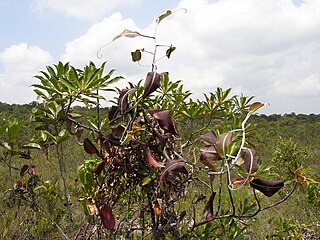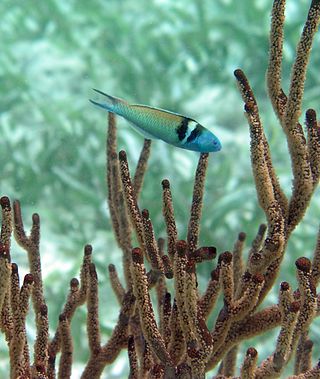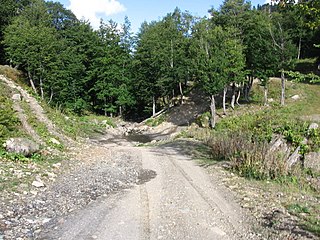Related Research Articles

The Great Victoria Desert is a sparsely populated desert ecoregion and interim Australian bioregion in Western Australia and South Australia.

Habitat conservation is a management practice that seeks to conserve, protect and restore habitats and prevent species extinction, fragmentation or reduction in range. It is a priority of many groups that cannot be easily characterized in terms of any one ideology.

The Sundaland heath forests, also known as Kerangas forest, is a type of tropical moist forest found on the island of Borneo, which is divided between Brunei, Indonesia, and Malaysia, as well as on the Indonesian islands of Belitung and Bangka, which lie to the west of Borneo.

Southwest Australia is a biogeographic region in Western Australia. It includes the Mediterranean-climate area of southwestern Australia, which is home to a diverse and distinctive flora and fauna.

Chessel Bay is a 12.9-hectare (32-acre) Local Nature Reserve on the east bank of the River Itchen in Southampton in Hampshire. It is owned and managed by Southampton City Council. It is part of Solent and Southampton Water Ramsar site and Special Protection Area, and of Lee-on-The Solent to Itchen Estuary, which is a Site of Special Scientific Interest. It has been a local nature reserve since 1989

Paul de Arzila is a Portuguese natural reserve occupying an area in Coimbra municipality, and neighbouring municipalities of Condeixa-a-Nova and Montemor-o-Velho. It is a biogenetical reserve with an area of 150 ha framed in a protected area of 535 ha, where 119 species of birds, 12 of mammals, 10 of reptiles, 13 of fish and 201 of spiders were inventoried.

The Sintra-Cascais Natural Park is a park on the Portuguese Riviera, one of the 13 Natural Parks of Portugal. While only established in 1994 as a Natural Park by the Portuguese Government, it has been protected since 1981. Its area is approximately 145 km2. The park includes the Serra de Sintra Mountain Range but extends all the way to the coast and Cabo da Roca, continental Europe's westernmost point. It contains the Castle of the Moors. Located within 25 km of Lisbon, the Sintra-Cascais Natural Park is a popular tourism area, with many different individual historical and natural sites and attractions. Sintra and Cascais are towns and municipalities in the Lisbon / Estoril Coast.

The protected areas of Nicaragua are areas that have natural beauty or significance and are protected by Nicaragua. Nicaragua has 78 protected areas that cover 22,422 km2, about 17.3% of the nations landmass. The National System of Protected Areas (SINAP) is administered by the Ministry of the Environment and Natural Resources (MARENA).

Since declaring independence in 1981, Belize has enacted many environmental protection laws aimed at the preservation of the country's natural and cultural heritage, as well as its wealth of natural resources. These acts have established a number of different types of protected areas, with each category having its own set of regulations dictating public access, resource extraction, land use and ownership.

Dersingham Bog is a 159.1-hectare (393-acre) biological and geological Site of Special Scientific Interest in Norfolk, England. It is a Nature Conservation Review site, Grade 2, a National Nature Reserve and a Ramsar site It is part of the Norfolk Coast Area of Outstanding Natural Beauty, and the Roydon Common & Dersingham Bog Special Area of Conservation Part of it is a Geological Conservation Review site.
Sankan Biriwa is a mountain massif in the east of Sierra Leone with two peaks, both over 1,800 metres, the northernmost is the second highest in Sierra Leone at 1,850 m. The mountain is part of the Tingi Hills Forest Reserve.

The Tagus International Natural Park is a protected area in Portugal and Spain. It is an important area for the conservation of several species of birds that nest on the rugged banks of rivers and surrounding areas. It is also one of the lowest human density areas in the Iberian Peninsula.

Southwest Alentejo and Vicentine Coast Natural Park (PNSACV) is a natural park located in southwest Portugal. It occupies an area of 895.7 km2 (345.8 sq mi) and is one of the last strongholds of the wild European coast. It has one of the highest levels of biodiversity in the country with over 12 endemic species of plant and several bird nesting sites.

Berlengas Natural Reserve is a Portuguese natural reserve in the Berlengas, a small archipelago off the coast of Peniche, Portugal. Over 98% of its 95.6 km2 (36.9 sq mi) are marine. The symbol of the protected area is the common murre, which has, or had, its southernmost nidifying population in the islands.

Sado Estuary Natural Reserve is a nature reserve in Portugal. It is one of the 30 areas which are officially under protection in the country. It is located between the municipalities of Alcácer do Sal, Comporta and Setúbal.
For other localities with the same name, see Tsaratanana (disambiguation)
Idanre Forest Reserve is in Idanre local government area of the Nigerian state of Ondo, in the south-west part of the country. This International Union for Conservation of Nature designated nature reserve covers 561 square kilometres (217 sq mi).It is a lowland rainforest with an altitude of 10 to 400 meters.

Pskhu-Gumista Strict Nature Reserve is a protected area in the Sukhumi District of Abkhazia, Georgia. The primary goal of the reserve is to protect flora and fauna of the area, including the surrounding mountainous region.

The Greater Antilles mangroves is a mangrove ecoregion that includes the coastal mangrove forests of the Greater Antilles – Cuba, Hispaniola, Jamaica, and Puerto Rico.

Savage Islands Nature Reserve is a Portuguese nature reserve located in the Savage Islands, a small archipelago in the Northeast Atlantic Ocean. Created in 1971, it is one of the oldest protected areas in the country. The strict nature reserve occupies an area of 2,677 km2 (1,034 sq mi) after its expansion in 2021, and over 99% of the total area is maritime.
References
- ↑ "Yulu | DOPA Explorer". dopa-explorer.jrc.ec.europa.eu. Retrieved 2023-04-13.
- ↑ Publisher 2 (2020-06-11). "Yulu Nature Reserve - National Tourism Map". Mapa Nacional de Turismo. Retrieved 2023-04-13.